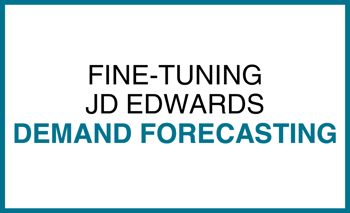
 Finding the right inventory ordering schedule is a struggle that most companies can relate to. From having out of stock items that you haven’t ordered enough of, to slow-moving items taking up valuable warehouse space, how do you find the right balance? Demand forecasting tools are a great way to estimate what needs to be ordered in the future, but only if you know how to leverage them effectively.
Finding the right inventory ordering schedule is a struggle that most companies can relate to. From having out of stock items that you haven’t ordered enough of, to slow-moving items taking up valuable warehouse space, how do you find the right balance? Demand forecasting tools are a great way to estimate what needs to be ordered in the future, but only if you know how to leverage them effectively.
A recent client was struggling with their demand forecasting through JD Edwards. While the standard JDE forecasting functionality can be incredibly helpful, our client was having some trouble getting accurate demand forecasts for their inventory.
Our client found that they were ordering too much product that wasn’t selling and not enough of what was selling. However, these purchasing decisions were being made based on their demand forecast. Our team stepped in to see if we could determine a better way to forecast their inventory demand.
JD Edwards has a number of forecasting methods to choose from, and determining the best fit can be a challenge. In order to evaluate how they were using JDE forecasting, we configured a version of forecasting that we thought best aligned with their organization. Instead of having it forecast for the future, however, our team set up forecasts for a six-month period in the past.
The idea behind this solution was to generate forecast data for a period of time where actual sales data existed. So, instead of forecasting into the future and hoping for the best, our team could gather the forecasted numbers and compare them to actual results from past months for accuracy. In comparing the data, we saw some big differences between the forecasted and the actuals.
With concrete data in front of them, our team was able to work with the client to refine the forecasting methods to see what was causing the discrepancies. One hiccup that was identified early was that the demand forecast was including sales histories from specific customer forecasts. This meant that they were double-dipping on customer forecasts, which altered their numbers.
For general demand forecasting, JD Edwards generates a forecast that it determines is the best fit and combines that with individual customer forecasts. Those two calculations combined result in the demand forecast for the organization. Through our review, we found that both the best fit and the customer forecasts were including sales histories, effectively doubling that information.
In order to solve this, our client needed to go back and refine their sales history in order to ensure a more accurate forecast. From there, they will be able to generate a demand forecast that more closely resembles their actual demand and can better inform their purchasing process.
This project highlights one of the many ways JD Edwards can improve your business processes, and how a JD Edwards Business Process Improvement check can help find solutions to challenges your business is experiencing. If you’re interested in a similar project, give our team a call.
Lorem ipsum dolor sit amet, consectetur adipiscing elit

For the past two decades, we've made it our business to help you work smarter. From commerce challenges to ERP customizations, we support the power of your big ideas by helping you work more strategically, more intuitively, and more efficiently.
2658 Scranton Road, Suite 3
Cleveland, Ohio 44113
216.369.3600
Comments (1)